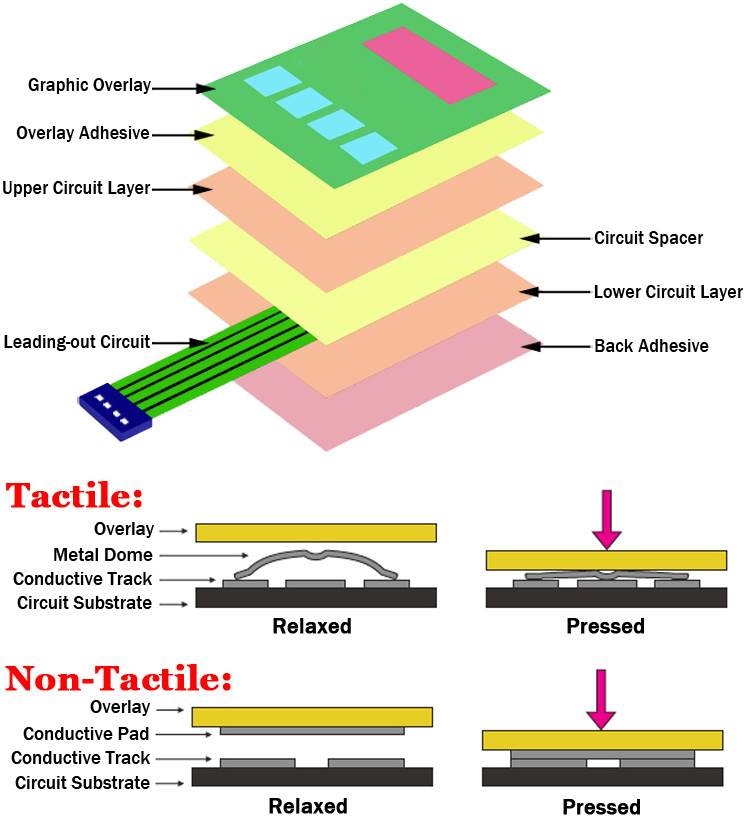Comprehending Membrane Layer Switches Over: The Key to Resilient and Dependable Controls
Membrane layer switches stand for a crucial aspect of contemporary user interface layout, blending functionality with resilience in numerous applications. As we discover the complexities of membrane buttons, it becomes clear that their role in boosting control systems is both extensive and complicated, elevating inquiries regarding exactly how finest to leverage their abilities in future developments.
What Are Membrane Layer Buttons?
Membrane layer switches are an innovative option in the world of interface modern technology, incorporating performance and style seamlessly. These tools act as an interface between individuals and digital systems, incorporating several components right into a small layout. Typically constructed from adaptable, thin layers of materials, membrane switches are created to respond to touch, allowing users to connect with equipment and electronic devices properly.
The main aspects of a membrane layer button include a printed circuit layer, graphic overlay, and a spacer layer that prevents unintentional activation. The graphic overlay can be tailored to mirror brand name identity or user preferences, boosting aesthetic appeals while ensuring functionality. Membrane layer buttons are typically used in various applications, consisting of clinical tools, customer electronic devices, and industrial equipment, owing to their durability and resistance to ecological aspects such as wetness and dust.
One of the essential benefits of membrane layer buttons is their capability to stand up to deterioration, making them ideal for high-traffic environments. In addition, they are light-weight and call for very little space, permitting for innovative designs in item advancement. Overall, membrane switches over stand for a sensible and effective option for modern digital interfaces, marrying modern technology with user-centric layout concepts.

Exactly How Membrane Switches Over Job
The procedure of membrane layer changes joints on a basic yet reliable device that converts user input right into digital signals. When a customer presses the button, the top layer flaws, permitting a conductive component in the circuit layer to make contact with a matching conductive pad on the bottom of the graphic overlay.
The layout of membrane switches can vary, yet they commonly include domes or tactile elements to supply comments to the individual, enhancing the overall experience. The materials utilized in membrane layer switches, such as polyester or polycarbonate, add to their durability and resistance to ecological factors, consisting of dampness and dust. The printed circuits are typically enveloped, which shields them from wear and tear over time.

Benefits of Membrane Layer Buttons
Among the key benefits of membrane layer switches is their convenience in layout, permitting them to be tailored to fulfill specific individual demands and aesthetic needs. This versatility includes different sectors, where different forms, dimensions, and colors can be utilized to enhance customer interaction and visual allure.
In addition, membrane layer switches are known for their longevity. Created from robust materials, they are resistant to dirt, dampness, and physical wear, which substantially expands their lifespan compared to standard review mechanical buttons. This toughness makes them particularly suitable for high-traffic atmospheres and applications needing longevity.

Furthermore, membrane layer buttons supply a streamlined account, resulting in a thinner style that can be incorporated right into numerous gadgets without including bulk. This feature not only improves the aesthetic charm yet additionally contributes to an extra ergonomic product design.

Applications of Membrane Buttons
Versatile and easy to use, membrane layer switches discover applications throughout a broad array of sectors, including clinical devices, consumer electronic devices, and commercial devices. In the more info here clinical area, these buttons are important to gadgets such as analysis tools, client surveillance systems, and infusion pumps, where integrity and simplicity of cleansing are essential. Their capacity to preserve and hold up against extreme environments capability makes them suitable for such applications.
In customer electronics, membrane switches are made use of in products like microwaves, cleaning machines, and remote controls - membrane switch. Their smooth style enables user-friendly interface, improving the general individual experience while offering resilience and resistance to deterioration
Commercial devices likewise profits from membrane buttons, particularly in control panels for machinery and automation systems. These buttons provide defense versus dirt and wetness, guaranteeing regular efficiency in difficult settings. In addition, their customizable functions permit makers to tailor them to certain functional demands, enhancing efficiency and capability.
Choosing the Right Membrane Layer Switch Over
When choosing a membrane layer button, it is vital to think about various factors that affect efficiency and viability for details applications. The key considerations consist of ecological conditions, responsive feedback, resilience, and design requirements.
First, analyze the operating environment; buttons revealed to dampness, chemicals, or severe temperatures call for specific products to make certain longevity and functionality. Next off, review the demand for responsive comments. Relying on individual communication, some applications might benefit from a responsive action to confirm activation, while others may like a non-tactile layout Check Out Your URL for aesthetic reasons.
Toughness is one more essential aspect; membrane buttons must be created to endure constant use, effects, and abrasion. Guarantee the selected button can withstand the anticipated lifecycle, particularly in high-usage circumstances.
Final Thought
In final thought, membrane changes serve as essential elements in the style of dependable and sturdy control systems throughout different industries. The convenience of membrane layer changes allows for tailored solutions that meet details functional demands, reinforcing their relevance in modern-day technology.
Membrane changes represent a crucial element of contemporary user interface style, mixing performance with strength in different applications.Membrane layer buttons are an advanced solution in the world of user interface technology, combining functionality and design perfectly. Typically created from adaptable, slim layers of products, membrane switches are created to react to touch, enabling customers to connect with machinery and digital gadgets successfully.
The style of membrane buttons can vary, however they often include domes or responsive aspects to offer comments to the user, enhancing the general experience.In conclusion, membrane layer switches over offer as crucial elements in the style of reputable and sturdy control systems across numerous markets.